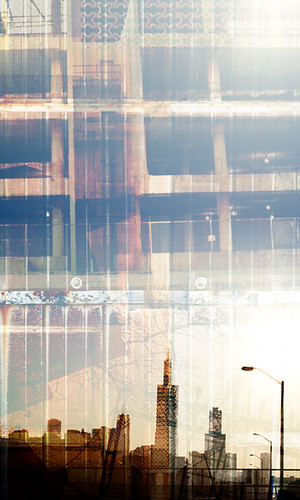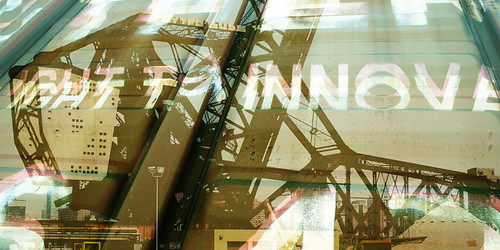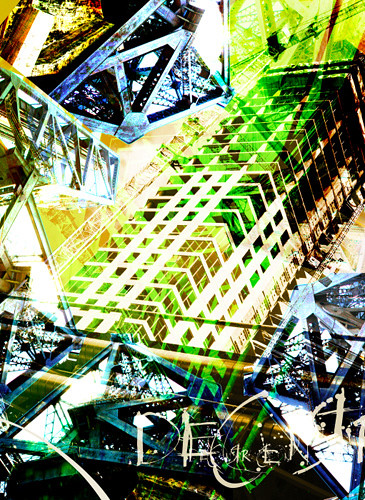
Event Horizon


South Loop and Urban Artery
Haas’ collages present a unique interplay between urban structures, as he creates decorative patterns inspired by the urban environment without completely abstracting its individual elements. Things radiate from all sides, giving the sense that the city’s lifeless objects play as equal a part in the life of the city as its inhabitants. Lights move purposefully toward a goal (Event Horizon), a building protects a passing train from the heat of the sun (South Loop), and train tracks pump energy into the streets they intersect (Urban Artery). We get a vision of a city that breathes with life independently of the living. It’s as if each element has its own personality, a unique character that adds a new angle to the piece as a whole. In turn, each piece acts out its own drama, and together they form a collection that provides a narrative for the soul of the city.

All 4 Ways and Stammering With Procedure
Haas plays with juxtaposition; objects taken out of context topple over one another, at once colliding with and supporting each other. At times we are bombarded by contradictory elements, as in Stammering With Procedure, where an exit-only staircase is half masked by a fence that seems to cry “no exit”. All 4 Ways at the same time commands you to “STOP” and to choose your way from any direction, up or down, right or left, or in between.

Vaulted Phantasm and Escape Within Reach
Looking at Escape Within Reach, one can’t help but wonder what would be more menacing: being stuck behind the barbed-wire fencing, or being lost in the unwelcoming sea of brick and concrete beyond its boundaries? What are we to make of a world where the ceiling is the sky and the sky is the ground we walk on, as in Vaulted Phantasm? In these, Haas turns the world on its head, and no direction is an obvious choice.
These contrasts are like the collisions of fears and fantasies, and the city acts as a playing field for these collisions. Haas’ collages are also a playing field, and, through their representation of urban environments, mimic their behavior and embody their spirit.


Metropolis Fall and Eventide Shimmer
While some pieces represent arenas for high-energy pursuits, others are more suggestive of a calmer, softer, more natural city. In Eventide Shimmer, a skyline of nondescript buildings reflects onto the pavement like trees on a lake, and what looks like the shimmer of sun on water reflects back at its walls. By giving the rundown door the color of wild berries, the originally unwelcome exterior becomes the sunset’s canvas. Metropolis Fall also alludes to the natural. Light seems to be creeping out of the cracks of buildings the way the sun’s rays peek through the leaves of trees in a forest or jungle. The scene feels like morning, the top half a snapshot of awakening structures in the city below. We are tempted by these pieces to view the city not as an artificial creation, but as a natural one.
Thus we are left not with one version of a city, but with a series of unrelenting dichotomies: between the natural and unnatural, between dreams and nightmares, and between purpose and aimlessness. And if to Haas the urban world is one of unyielding clashes, then he remains attune, too, to the ever-present gray area of any two-sided battle.

Inner City Arachnid
We see this gray area in Inner City Arachnid. It’s not loud or frightening, but it’s not at peace either. It’s like the city hung-over, the city taking a break from winning or losing by simply not fighting. The repeated lettering, as if looking through half-open eyes, suggests a playing field that is open for viewing, but only partially. Is it a moment of recovery or a moment of delusion? Should we expect confusion or clarity ahead? There is an ambiguous feeling of motion in the piece that adds to this sense of uncertainty. On the one hand, the bouncing letters seem to be a reflection, perhaps off of the windowpane of a car that is speeding by, on the way to some destination. The crane-like machine, in this case, is only a passing view, and we anticipate that the blur will soon pass as well. On the other hand, one can view the piece as a still life, a snapshot of the ponderous machine waking up to a new day, as heavy and monotonous as the one before it. In this case, one might be less eager for the blur to pass, and for reality to present itself clearly. The spectrum of Haas’ work suggests that all possibilities could be true, and that whatever chaos the city may bring, it is one crying out with opportunity.


Deconstruction and Hot Rod Flower
Haas’ pieces are in this way a celebration without glamorization, at once aggressive and reflective, overwhelming and engrossing, humbling and invigorating. And despite the absence of people in all of Haas’ work, we cannot help but remember that all of its structures are human creations. In Deconstruction, the graffiti that sits at the bottom right of the print is like the initials of an artist on his painting, except here, the city is the canvas, and its elements are simultaneously artist and artwork. Instead of fearing the brutality of the city’s inorganic structures, we’re asked to appreciate the life and energy that they pump through the veins and arteries of the metropolises that we ourselves have fashioned, and through which we have flourished.
To see more artwork by Nick Haas, visit www.haastyle.com.

1 comment:
great photos.like it
kiss
Chicmuse
http://thechicmuse.blogspot.com
Post a Comment